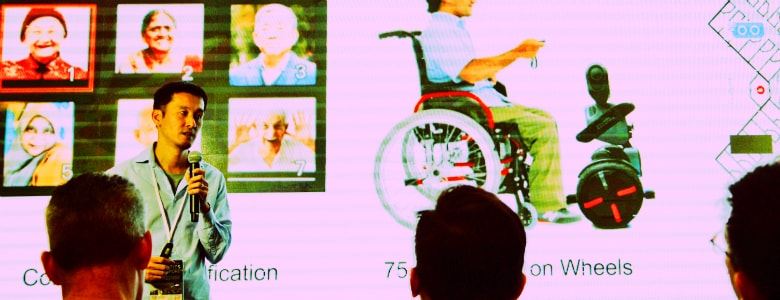Healthy Robotics

Most people spend their weekends relaxing and recharging for the week ahead.
But the 83 people taking part in MIT Hacking Medicine Robotics Singapore 2017 chose otherwise.
Instead, they spent 10-12 February hunkered down at SGInnovate’s headquarters in Carpenter Street, running on little sleep — and powered, it seems, by pure adrenaline and ideas.
The 48-hour hackathon, which was sponsored by SGInnovate and Segway Robotics, focused on using robotics to address unmet needs in elderly care. MIT Hacking Medicine and the Singapore-MIT Alliance for Research and Technology (SMART) were among the partner organisations for the event.
Participants — a diverse mix of clinicians, programmers, developers, engineers, designers and business managers — were tasked with using the Loomo Segway Robotics platform to implement their ideas.
The Loomo robot combines a self-balancing Segway transporter with artificial intelligence capabilities such as autonomous navigation, speech, and facial and voice recognition.
After two intense days and nights, each of the 12 teams pitched their ideas and live demos to a panel of expert judges, which comprised:
- SGInnovate CEO Mr Steve Leonard;
- VentureCraft investment director Mr Ong Jeong Shing;
- Segway Robotics business lead and head of developer partnerships Ms Sarah Zhang;
- Integrated Health Information Systems Innovation Labs head Mr Gerard Chew;
- Active Global Specialised Caregivers CEO Ms Yorelle Kalika;
- Professor Li Haizhou from NUS Department of Electrical and Computer Engineering.
Personal Botler
By 2030, the number of Singaporeans aged 65 and older is projected to double to 900,000.
By then, one in four Singaporeans will require elderly care, a situation which will place considerable strain on the healthcare system. As populations age worldwide, this problem will not be unique to Singapore.
The use of robots, together with other smart monitoring systems and mobile applications, could thus go a long way towards reducing the workloads of human caregivers.
The hackathon’s winning team, Botler, turned the Loomo into an autonomous system for transporting wheelchair-bound elderly residents in nursing homes.
The system uses facial recognition algorithms to identify residents, docks with their wheelchairs via a custom-designed electromagnetic universal adaptor that fits all wheelchair makes, and then moves them to where they need to go — to meals, activities or medical appointments, for example.
This frees up manpower, allowing human caregivers to focus on other tasks such as providing better medical care. Botler is cheaper and much less bulky than motorised wheelchairs, and could also be used to move other heavy items such as beds and food trolleys.
Botler team leader Mr Kok Yuan Yik, a research assistant at Nanyang Technological University’s Robotics Research Centre, said that the team included people from different backgrounds, including a doctor, a recent polytechnic graduate and a project manager.
“But we shared the same vision: to use Loomo to turn a normal mobile platform into a smart, autonomous mobile platform. Because of Loomo’s special capabilities, we thought it would be easy to integrate it into any wheelchair,” Mr Kok told TechNews.
“Personally, I really hope to see our product being used by the elderly. We hope to work closely with SGInnovate to see how we can make this a reality,” he added.
NOW and Dori
Second prize winners Team DORI addressed the problem of late detection of dementia, which often leads to rapid cognitive decline in the elderly.
They designed a social robot that can draw from a database of questions to assess an elderly person’s cognitive health in a personalised, non-threatening manner, thus allowing signs of cognitive decline to be picked up early.
The robot can also chat with the user, play music and videos, and facilitate social interactions by calling the user’s family, friends or volunteers.
Hypertension and stroke are also major concerns for Singapore’s aging population.
Team NOW clinched the hackathon’s third prize with their design of a robotic Nurse-on-Wheels (NOW), which integrates with smart health monitoring devices to monitor the elderly user’s blood pressure.
If the blood pressure is high, NOW contacts a healthcare professional, who assesses the patient remotely and makes a virtual diagnosis. If a stroke is deemed to be imminent, NOW will dispatch an emergency response team to the user’s home.
In these situations, the mobility of the Loomo system is an advantage, as it can follow high-risk users around their homes in case of a crisis.
From ideas to impact
Dr Howard Califano, director of the SMART Innovation Centre, said that the goal of the hackathon was to convene a diverse group of people around the concept of robotics for healthcare.
But it was not meant to be a mere exercise in thought.
“We want to help you through this ideation stage; The goal is that the process you started can eventually have an impact on healthcare,” he said.
The winning teams will continue to have access to prototyping facility labs, the Loomo platform and funding opportunities to further develop their ideas into marketable prototypes.
“We look forward to working closely with Botler and others who want to move their work from research to real-world, and to make a positive impact on lives around the world,” said SGInnovate CEO Mr Steve Leonard.
“Working with the MIT Hacking Medicine team is exactly what we do at SGInnovate, helping ambitious and capable people use various technologies to create possible solutions to global challenges.”
https://www.tech.gov.sg/media/technews/healthy-robotics
